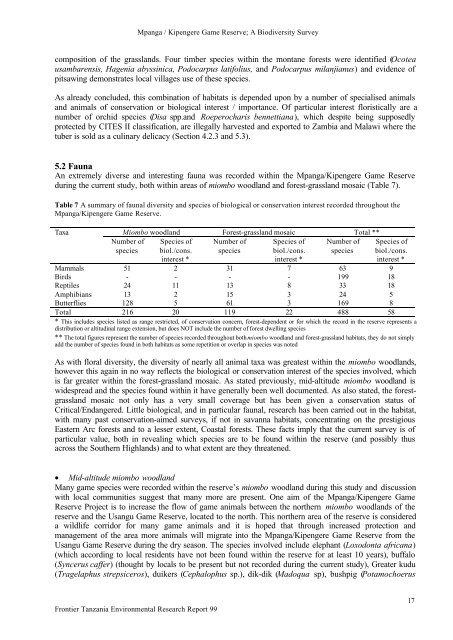Mpanga/Kipengere Game Reserve - Frontier-publications.co.uk
Mpanga/Kipengere Game Reserve - Frontier-publications.co.uk
Mpanga/Kipengere Game Reserve - Frontier-publications.co.uk
You also want an ePaper? Increase the reach of your titles
YUMPU automatically turns print PDFs into web optimized ePapers that Google loves.
<strong>Mpanga</strong> / <strong>Kipengere</strong> <strong>Game</strong> <strong>Reserve</strong>; A Biodiversity Survey<br />
<strong>co</strong>mposition of the grasslands. Four timber species within the montane forests were identified (O<strong>co</strong>tea<br />
usambarensis, Hagenia abyssinica, Podocarpus latifolius, and Podocarpus milanjianus) and evidence of<br />
pitsawing demonstrates local villages use of these species.<br />
As already <strong>co</strong>ncluded, this <strong>co</strong>mbination of habitats is depended upon by a number of specialised animals<br />
and animals of <strong>co</strong>nservation or biological interest / importance. Of particular interest floristically are a<br />
number of orchid species (Disa spp.and Roeperocharis bennettiana), which despite being supposedly<br />
protected by CITES II classification, are illegally harvested and exported to Zambia and Malawi where the<br />
tuber is sold as a culinary delicacy (Section 4.2.3 and 5.3).<br />
5.2 Fauna<br />
An extremely diverse and interesting fauna was re<strong>co</strong>rded within the <strong>Mpanga</strong>/<strong>Kipengere</strong> <strong>Game</strong> <strong>Reserve</strong><br />
during the current study, both within areas of miombo woodland and forest-grassland mosaic (Table 7).<br />
Table 7 A summary of faunal diversity and species of biological or <strong>co</strong>nservation interest re<strong>co</strong>rded throughout the<br />
<strong>Mpanga</strong>/<strong>Kipengere</strong> <strong>Game</strong> <strong>Reserve</strong>.<br />
Taxa Miombo woodland Forest-grassland mosaic Total **<br />
Number of<br />
species<br />
Species of<br />
biol./<strong>co</strong>ns.<br />
Number of<br />
species<br />
Species of<br />
biol./<strong>co</strong>ns.<br />
Number of<br />
species<br />
Species of<br />
biol./<strong>co</strong>ns.<br />
interest *<br />
interest *<br />
interest *<br />
Mammals 51 2 31 7 63 9<br />
Birds - - - - 199 18<br />
Reptiles 24 11 13 8 33 18<br />
Amphibians 13 2 15 3 24 5<br />
Butterflies 128 5 61 3 169 8<br />
Total 216 20 119 22 488 58<br />
* This includes species listed as range restricted, of <strong>co</strong>nservation <strong>co</strong>ncern, forest-dependent or for which the re<strong>co</strong>rd in the reserve represents a<br />
distribution or altitudinal range extension, but does NOT include the number of forest dwelling species<br />
** The total figures represent the number of species re<strong>co</strong>rded throughout both miombo woodland and forest-grassland habitats, they do not simply<br />
add the number of species found in both habitats as some repetition or overlap in species was noted<br />
As with floral diversity, the diversity of nearly all animal taxa was greatest within the miombo woodlands,<br />
however this again in no way reflects the biological or <strong>co</strong>nservation interest of the species involved, which<br />
is far greater within the forest-grassland mosaic. As stated previously, mid-altitude miombo woodland is<br />
widespread and the species found within it have generally been well documented. As also stated, the forestgrassland<br />
mosaic not only has a very small <strong>co</strong>verage but has been given a <strong>co</strong>nservation status of<br />
Critical/Endangered. Little biological, and in particular faunal, research has been carried out in the habitat,<br />
with many past <strong>co</strong>nservation-aimed surveys, if not in savanna habitats, <strong>co</strong>ncentrating on the prestigious<br />
Eastern Arc forests and to a lesser extent, Coastal forests. These facts imply that the current survey is of<br />
particular value, both in revealing which species are to be found within the reserve (and possibly thus<br />
across the Southern Highlands) and to what extent are they threatened.<br />
• Mid-altitude miombo woodland<br />
Many game species were re<strong>co</strong>rded within the reserve’s miombo woodland during this study and discussion<br />
with local <strong>co</strong>mmunities suggest that many more are present. One aim of the <strong>Mpanga</strong>/<strong>Kipengere</strong> <strong>Game</strong><br />
<strong>Reserve</strong> Project is to increase the flow of game animals between the northern miombo woodlands of the<br />
reserve and the Usangu <strong>Game</strong> <strong>Reserve</strong>, located to the north. This northern area of the reserve is <strong>co</strong>nsidered<br />
a wildlife <strong>co</strong>rridor for many game animals and it is hoped that through increased protection and<br />
management of the area more animals will migrate into the <strong>Mpanga</strong>/<strong>Kipengere</strong> <strong>Game</strong> <strong>Reserve</strong> from the<br />
Usangu <strong>Game</strong> <strong>Reserve</strong> during the dry season. The species involved include elephant (Loxodonta africana)<br />
(which ac<strong>co</strong>rding to local residents have not been found within the reserve for at least 10 years), buffalo<br />
(Syncerus caffer) (thought by locals to be present but not re<strong>co</strong>rded during the current study), Greater kudu<br />
(Tragelaphus strepsiceros), duikers (Cephalophus sp.), dik-dik (Madoqua sp), bushpig (Potamochoerus<br />
<strong>Frontier</strong> Tanzania Environmental Research Report 99<br />
17

















